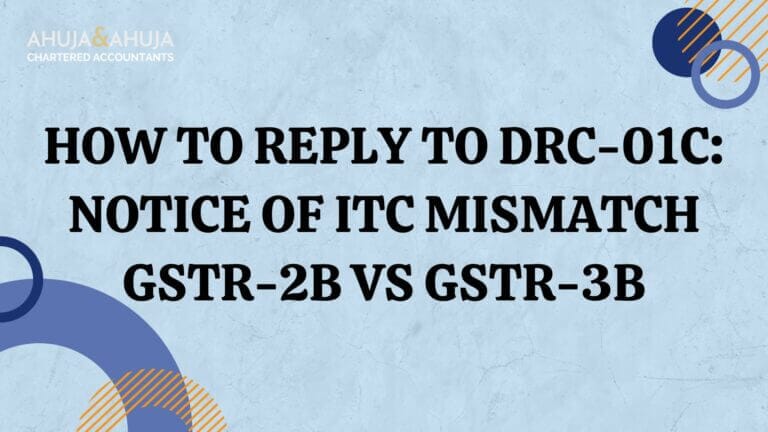GST on Gangajal : Latest Clarification
The world of indirect taxes has always been complex, but the advent of the Goods and Services Tax (GST) in India streamlined multiple indirect taxes into a unified system. However, there are still instances where the application of GST sparks debates and concerns. One such recent event involves the holy water known as Gangajal widely used in Indian religious practices. This article aims to clarify and explain in-depth the latest clarification from the Central Board of Indirect Taxes and Customs (CBIC) regarding the applicability of GST on Gangajal. We aim to break through the complex jargon and lay out the implications in an easy-to-understand language.
In the upcoming sections, we will delve into the significance of Gangajal, the concept of GST, recent media reports around this issue, and finally CBIC’s clarification on the same. We also intend to explore the implications on the public and dispel any misconceptions with the help of a dedicated FAQ section. By the end of this comprehensive guide, we hope to leave you with a clear understanding of this hot-button issue.
Background on Gangajal and Its Significance
Gangajal, the holy water from the Ganges, holds immense cultural and spiritual significance in India. The river Ganga, often considered sacred, flows through various parts of the country and is revered as a deity by millions of people.
Gangajal is not just any ordinary water; it is believed to possess purifying properties. Devotees view it as a divine substance with the power to cleanse sins and bring spiritual upliftment. It is used extensively in religious rituals, ceremonies, and pujas (worship) conducted in households and temples across the nation.
The act of bringing Gangajal from the holiest cities along the Ganges, such as Haridwar and Varanasi, is considered auspicious. People undertake pilgrimages to these places to collect the sacred water and bring it back to their homes as a symbol of spiritual purity and blessings.
The practice of using Gangajal in pujas and religious ceremonies has been followed for centuries and forms an integral part of Indian traditions and customs. Its significance transcends geographical boundaries and religious affiliations, touching the lives of people from diverse backgrounds.
Overview of GST
Before we proceed to discuss the applicability of Goods and Services Tax (GST) on Gangajal, it is essential to understand the concept of GST itself.
GST is a comprehensive indirect tax levied on the supply of goods and services in India. It was introduced on July 1, 2017, with the objective of simplifying the previous complex tax structure and creating a unified and efficient taxation system. GST subsumed several central and state taxes, including Central Excise Duty, Service Tax, Value Added Tax (VAT), and others.
Under the GST regime, goods and services are categorized into different tax slabs: 5%, 12%, 18%, and 28% (subject to specific exceptions). The applicable tax rate depends on the nature of the goods or services being supplied.
Businesses fulfilling certain criteria, such as exceeding a particular turnover threshold, are required to register for GST. GST registration enables businesses to collect GST from their customers, claim input tax credits, and fulfill various compliance requirements.
GST has brought transparency and efficiency to the tax system, ensuring that taxes are levied at each stage of the supply chain. It aims to create a level playing field for businesses and simplify the overall taxation process.
GST & Gangajal: Recent Media Reports
Recently, there have been numerous media reports suggesting that the government has imposed an 18% GST on Gangajal. These reports created a wave of concern and debate among the public, as Gangajal holds deep religious and cultural significance.
The media reports caused confusion among the masses, as they contradicted the understanding that Gangajal falls under the category of puja samagri (religious items), which is exempt from GST. In fact, the exemption of puja samagri from GST has been discussed extensively in the 14th and 15th meetings of the GST council held on May 18-19, 2017, and June 3, 2017, respectively. It was decided to keep puja samagri in the exempt list, ensuring that these items have been exempt from GST since its introduction.
To address these concerns and clarify the situation, the Central Board of Indirect Taxes and Customs (CBIC) issued an official clarification regarding the applicability of GST on Gangajal.
CBIC’s Clarification on GST & Gangajal
In response to the media reports about the imposition of GST on Gangajal, the Central Board of Indirect Taxes and Customs (CBIC) has issued a crucial clarification. The CBIC’s official statement emphatically refutes these reports and affirms that Gangajal remains exempt from GST.
The CBIC’s clarification is rooted in the recognition of Gangajal as a sacred and religious item, deeply ingrained in the cultural and spiritual fabric of India. According to the CBIC, Gangajal falls under Schedule III of the Goods and Services Tax Act, 2017, which lists activities or transactions that are neither considered as a supply of goods nor a supply of services. This reaffirms the special status accorded to Gangajal, exempting it from the purview of GST.
To dispel any confusion that may have arisen from the media reports, the CBIC highlights the distinction between Gangajal and commercially sold drinking water bottles. While drinking water bottles attract an 18% GST rate, Gangajal remains exempt from GST due to its unique religious significance.
The CBIC’s clarification aims to alleviate concerns and misconceptions that had arisen in light of recent media coverage. It reaffirms the government’s respect for the sanctity of religious items and aims to ensure that no unwarranted taxation is levied on items of such cultural and spiritual importance.
Impact on the Public
The recent clarification by the CBIC regarding the exemption of Gangajal from GST brings relief and reassurance to millions of Indians who value its cultural and spiritual significance. The clarification ensures that no unwarranted taxation is levied on this revered substance, preserving the cherished traditions and beliefs associated with it.
The public can now continue to use Gangajal in their religious rituals, ceremonies, and pujas without the burden of additional taxes. It upholds the sanctity of religious items and acknowledges their unique status in the Indian cultural landscape.
This clarification also contributes to fostering a sense of respect and understanding for the diversity of religious practices and customs prevalent in India. It recognizes the importance of religious sentiments and ensures that the taxation system does not impede the free expression of one’s faith.
By exempting Gangajal from GST, the government acknowledges its role as a custodian of cultural heritage and demonstrates its commitment to preserving the integrity of sacred customs.
Frequently Asked Questions (FAQs)
Is GST applicable to religious items in India?
GST applies to most goods and services in India. However, certain religious items, including Gangajal, fall under the exempt list of GST. The exemption recognizes the cultural and spiritual significance of these items.
Was GST ever imposed on Gangajal?
No, Gangajal has always been exempt from GST since its introduction. Media reports suggesting otherwise have been clarified by the CBIC, confirming the continued exemption of Gangajal from GST.
How does the CBIC differentiate between drinking water and Gangajal for tax purposes?
The CBIC draws a distinction between commercially sold drinking water bottles and Gangajal based on their intended use and religious significance. While drinking water bottles attract an 18% GST rate, Gangajal remains exempt from GST due to its unique religious connotation.
Conclusion
The recent clarification from the CBIC brings clarity and reassurance regarding the exemption of Gangajal from GST. It reaffirms the special status of Gangajal as a sacred and religious item, ensuring that no unwarranted taxation is imposed on such items of cultural and spiritual importance. The exemption upholds cherished traditions and beliefs while fostering respect for diverse religious practices.
It is essential to stay informed and rely on official clarifications, like the one provided by the CBIC, to dispel any misconceptions or concerns related to GST and religious items. This ensures that individuals can continue to practice their faith and engage in religious rituals without undue financial burdens.
By respecting and safeguarding the sanctity of religious items, the government showcases its commitment to preserving cultural heritage and promoting harmony in our diverse society.
Disclaimer
The materials provided herein are solely for educational and informational purposes. No attorney/professional-client relationship is created when you access or use the site or the materials. The information presented on this site does not constitute legal or professional advice and should not be relied upon for such purposes or used as a substitute for professional or legal advice.







